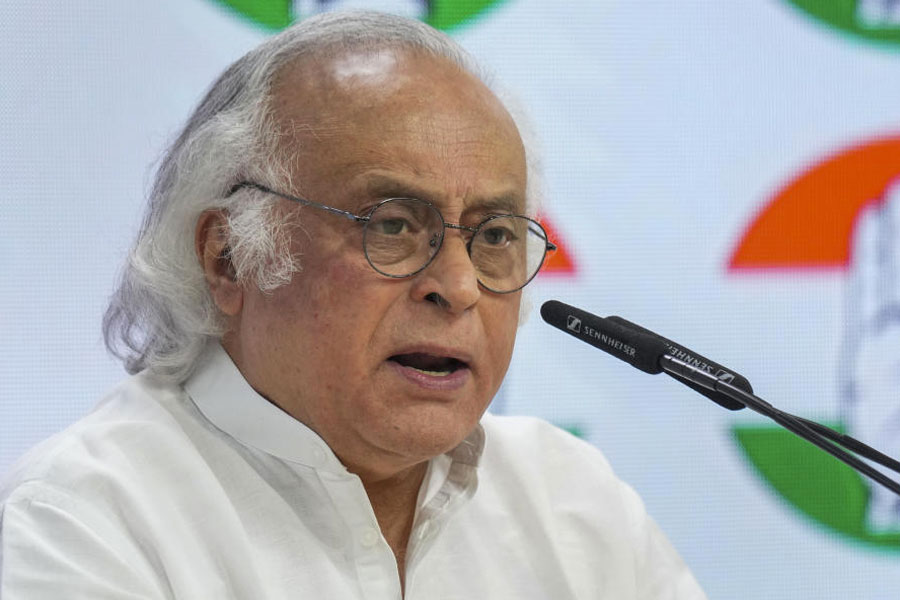 |
 |
| A residential building is inundated in Sundarpada area on the city outskirts owing to flood in the Daya river and (below) residents wade through a low-lying waterlogged area in Bhubaneswar. Pictures by Ashwinee Pati |
Bhubaneswar, Sept. 18: The state government has woken up to ensure better drainage system for the city to check urban flooding. It has asked the civic and development agencies to take steps to check encroachments blocking natural drainage channels and restrict illegal constructions in the flood-affected zones on city outskirts.
Official sources said chief minister Naveen Patnaik convened a meeting of the Bhubaneswar Development Authority, the Bhubaneswar Municipal Corporation, the water resources department and the public works department yesterday. Naveen took stock of the drainage situation and asked the authorities to take the renovation work of all the 10 water channels.
Earlier, drainage division, Cuttack of the water resources department had taken the renovation plan of four channels for which Rs 68 crore were earmarked by the Jawaharlal Nehru National Urban Renewal Mission. Earlier in February and July, Naveen also asked officials of the drainage division to expedite the renovation work in all channels.
Under the corporation area only 30 per cent roads have drains. Therefore, the civic authorities are receiving flak for waterlogging. The state government asked the corporation authorities to ensure more drains for the city roads, so that the storm water can be channelised properly. The public works department officials were also asked to ensure drainage along with all their roads.
“The corporation and the development authority were asked to have a joint-eviction squad to ensure free flow of water in the natural drainage channels. The squad will work in identifying the vulnerable points such as the NH-5 and Acharya Vihar meeting point where encroachment on drainage channel No. 4 has resulted in flood-like situations,” said a senior revenue official.
With 10 natural drainage flowing through the city, it is found that because of illegal encroachment, many drains are not getting adequate space for discharging storm water. Moreover, the Gangua nullah, the carrier of all output from the drainage channels, is also getting choked owing to siltation.
A senior corporation official admitted that though still 70 per cent of roads under the corporation lack drains, the existing ones are affected by dumping of solid wastes by the citizens. The practice is affecting the flow of storm water in the natural drainage channels. “There should be a serious awareness drive on educating public,” he said.
“As the Gangua nullah full with silt and natural drainage channels blocked by solid wastes and remaining unattended for years, the water discharge by the city drainage system is not becoming effective. While the width of the Gangua, in many places, vary from 40 to 120 feet as per the development authority’s master plan, it is reduced to 12 to 35 feet delaying the final discharge through the nullah and causing waterlogging in the drainage channels,” he said.
Housing and urban development secretary Sourabh Garg said: “The process has already started to equip the development authority with an effective demolition squad with high-end equipment to demolish the illegal structures coming up in the high-flood zones on the city outskirts.”
In a report Flout rules and float, The Telegraph first brought the issue of the multi-storeyed structures flouting the development authority’s building regulations as those had come up in the flood-affected zones along Sundarpada-Jatni Road.
“As the areas beyond Sundarpada are already included in the proposed enhanced development authority’s jurisdiction, it should swiftly act to include the notified areas,” said a real estate developer. The Centre has already formulated the national guidelines on management of urban flooding and it has focused on urban flooding de-linking it from riverine flood which affects extensive rural pockets.
It has sent the guidelines to the state government, so that the civic bodies can implement them as soon as possible.
“The corporation and the development authority should act quickly as urban flooding is different from rural flooding and at times the developed catchment owing to unplanned urbanisation can lead to very high run-off with flood peaks from 1.8 to 8 times of the regular rural flood,” said Piyush Ranjan Rout, an urban planning consultant.
Retired engineer-in-chief of the public works department Nandanandan Das said: “Safety of the residents should be priority of the civic administration and the issue such as encroachment should be dealt with iron hands.”










